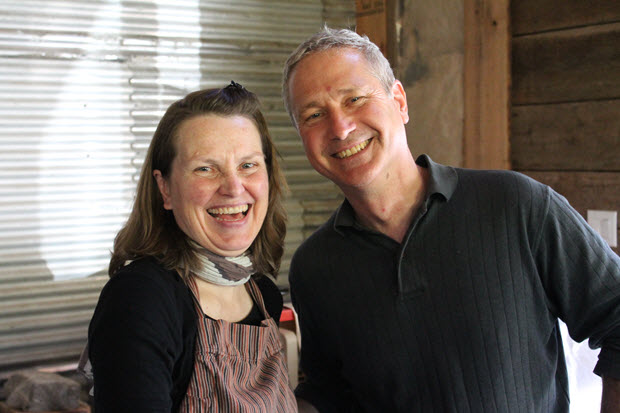
COWICHAN VALLEY, British Columbia
Victor Vesely and his wife Margit Nellemann believe the artisan wulong from their six-year “experiment” is finally ready for prime time. And the residents of the coastal Cowichan Valley are as ready as they are.
Six years is not a long time to master tea, given its centuries of development, so expectations visiting Westholme Tea Farm were not high. But the combination of the region’s ideal growing conditions and the growers’ sensitive palates has produced something very worthy of the title of Canada’s First Tea Farm.
The couple has succeeded in their mission to produce decent tea in Canada, but there is a confession to make in telling their story: In 2010, taking a chance that the warm microclimate along the southeast coast of Vancouver Island would be a good place to grow tea, they planted hardy Russian tea seedlings originally from Sochi. These were purchased from a grower in the southern United States due to regulations that make it easier to transfer agriculture products over the U.S. border.
They tried to coddle the plants through their first harsh winter by covering the plants to protect them. However, doing so crushed the young plants under the weight of the snow. They found that those left to their own devices were well protected by an insulating layer of snow, without the need for additional protection. Lesson learned.
As avid tea drinkers, the Cowichan couple wanted to create a local source for quality tea. Now that the first 800 plants are thriving in this environment, their dream of planting up to 4,000 is not as far-fetched as it may have once seemed. People living on Vancouver Island are know to be hardy, rustic folk that assume a laid back “island time” style. But with a growing farm and a growing tea business to go with it, 14–18 hour days are not uncommon for the duo. They have learned to adapt while preparing their products for sale beyond the farmers market where they got their start.
Nellemann, a potter, cherishes her time in the studio where she creates ceramic vessels and artwork. Warm and receptive, she tries to squeeze out some time for her art between farming and doing all of the physical tea blending. Vesely is the face of the business, but the dirt under his fingernails reveals how active he is in all aspects. Welcoming and charming, he is proud of how far they have come from new landowners to organic farming innovators and tea blenders.
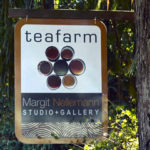 “Our passion for tea first took center stage in 2008, when we transformed two giant tipis into tea houses for a local Art + Tea event. Then, in 2010, we cast our lot entirely with tea culture by planting 200 Camellia sinensis seedlings on the south-facing slopes of the farm. ARTFARM became TEAFARM, and the old barn became a tea shop and tasting room,” says Vesely.
“Our passion for tea first took center stage in 2008, when we transformed two giant tipis into tea houses for a local Art + Tea event. Then, in 2010, we cast our lot entirely with tea culture by planting 200 Camellia sinensis seedlings on the south-facing slopes of the farm. ARTFARM became TEAFARM, and the old barn became a tea shop and tasting room,” says Vesely.
The pair describe the venture as an “experience,” or an experiment that’s still in progress. It involves growing and processing tea and creating an array of beautiful blends and delicious desserts, but it also makes them presenters of tea culture.
A walk in the garden
A walk through the farm with Vesely provides insight into the process. On a September day last year, 800 plants decked the south-facing hillside, lining both sides of the driveway.
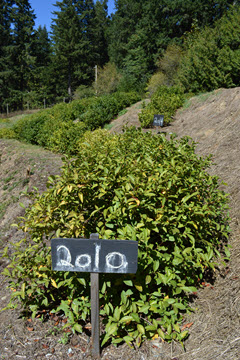
The 2014s were planted in rows perpendicular to the 2010s and they are now flourishing. They look healthy, if a bit wild (there are plans to square them off in traditional tea bush style, but for now, it’s hands off).
The former cattle and horse farm has rich soil protected from the wind and rain by surrounding hills and trees. The unique terroir has a vein of clay, coincidentally running right down the hill and under the barn that houses Nellemann’s studio. The soil is built up with hay. A uniquely Canadian touch are the maple leaves and shavings used as mulch for plants along the lower level (the upper ones don’t get the maple… it’s an experiment!). The maple wood is used for smoking the tea.
Weeding is done by hand. “We need to catch up a little on that… but we don’t like to overfarm,” says Vesely. Leafing is kept off the ground to prevent rot and infestation. A few of the upper plants have root weevils, but it’s not spreading and the stress it puts on the plant generates its own flavor variation, he explains.
They just took down some Buddleia (butterfly bush), considered an invasive species. It’s pretty but not ideal for the ecosystem, according to Vesely. Calendula, an excellent pairing plant, grows interspersed with the tea plants, offering shade and protection from pests.
Celsius temperatures in the high 30s (close to 100 degrees Fahrenheit) stress the plants. Vesely does a little bit of top irrigation to keep them cool. The plants definitely appear to feel the late summer heat, which he says is fine for the kukicha and hojicha harvest.
Some plants show an early bloom (which normally happens in October and November). In most cases, the tea fruit is harvested. The Liberty Distillery in Vancouver has used the farm’s tea blossoms in its botanical gin. The smell is “as if a gardenia made love to a jasmine,” according to Vesely. Unfortunately, during processing, the fragrance is impossible to capture for use in perfumes or essences. Locals do harvest some of the blossoms and reduce them to add to face creams and oils, but that’s a whole other project for down the line, he says.
Visitors sometimes expect to see an expansive landscape like photos they’ve seen of of vast tea gardens in India of hills planted with hundreds of thousands of tea bushes. But Vesely and Nellemann are primarily importers and blenders of tea. The “experiment” on the tea farm attracts attention and offers a hands-on experience, but volume is too small to sustain the entire operation. “Someone will come along and do it on a large scale, and we wish them well,” he says. “We will always be the first.”
Tasting the tea
After the gallery and the landscape, it’s time to venture into the tea room to sample the tea.
Tea is accompanied by desserts as fine as those in any five-star hotel’s tea room. Here, they were shaded under umbrellas in the midst of raw farmland. Shortbread, cheesecake, brownies, cakes, ice cream, and sorbet were all beautifully presented in this rustic setting, and tasted delicious. All the teas were served in Nellemann’s whimsical tea cups. The one savory item on the menu, scones, were sold out.
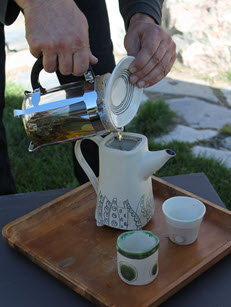
Pairings were very good, starting with a light Canadian Island Green tea, served in another of Nellemann’s creations, a funky, hand-shaped ceramic teapot. The liquor was green, faintly orange and clear, with a light clean taste. Broken green leaves were similar to the famous Chinese green tea Lu An Gua Pian. It had a slight astringency and a refreshing, sweet, slight citrusy taste with a clean finish. The second steeping was less astringent and smoother.
The tea was paired with a rhubarb jasmine sorbet that was lovely, cool, and refreshing. Then, a delectable smooth matcha cheesecake with a hazelnut crust. Exquisitely light and buttery shortbread cookies made with ground tea were another great complement.
Next came the Swallow Tale Oolong, 2nd Flush. Vesely served it in a glass vessel reminiscent of science class; it’s not your grandma’s afternoon tea. The oolong was smooth and sweet with some smoke and sweet spice on the leaf and a full amber liquor with notes of sweet stone fruit. It was served with a raw chocolate brownie made with Medjool dates and hemp seeds, and a Keemun chocolate torte, featuring port and tea-infused cranberries, yet another perfect match with the oolong.
The staff favors a woody brew that was pleasantly reminiscent of a musky campsite in the Algonquin pine forest. This was Westholme Tea Farm’s take on a Japanese Kukicha. A small glass pot of twigs arrived, much like a miniature log jam floating on a pale straw liquid. It was a nutty and smooth cup, they call Quail’s Nest. There wasn’t time for a second steeping but it paired well with the Lapsang Souchong & Star Anise Ice Cream.
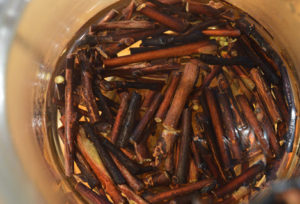
Vesely reinforced the company’s “give back to the earth” philosophy by pouring any leftover tea back into the ground so that it “nourished and grew the teas.” Good humor and respect for the process marked every aspect of the experience.
The servers at the Tea Farm are joyful and zealous, prepared to go through the entire menu and related the history of the farm. They help during harvest, which gives them a better appreciation of how precious the product is they are serving. Vesely poses the quaint notion this land “wanted to be a tea farm.”
In the way that experienced chefs know how to season aggressively and create signature dishes, well-established tea manufacturers manipulate their leaves to coax distinctive flavor profiles, developed over time and now familiar to drinking audiences. In this context, Canada’s first tea farm is decidedly Canadian: polite and in development within pristine growing conditions, with all the ingredients for a great cup.
The Westholme Tea Farm offers a joyful tea experience suited to even the most refined palate. The evolution of the property and the owners’ own personal development in creating an identity and establishing a niche market has been rewarded by much local enthusiasm for wares. Estate-grown Canadian tea has found a western home.
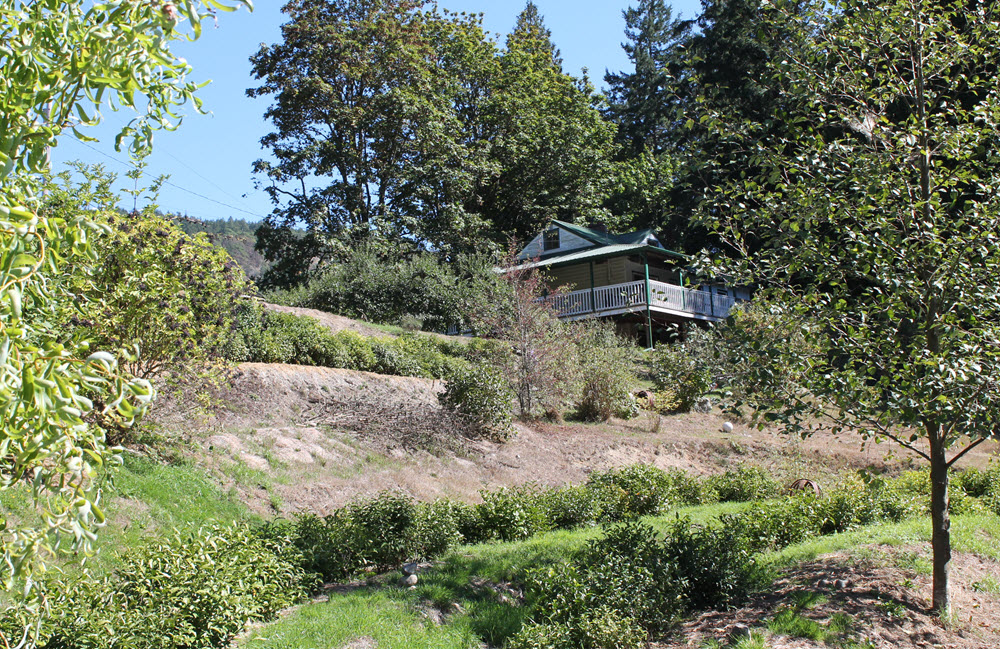
Tea Market
Get More Value from Your Tea: BRU Maker One
+41794574278
Jacque's Organics
(647) 804-7263
Great article, Rita!
Thank you Anne!
Rita,
Well written and informative article.
Thank you Donna!